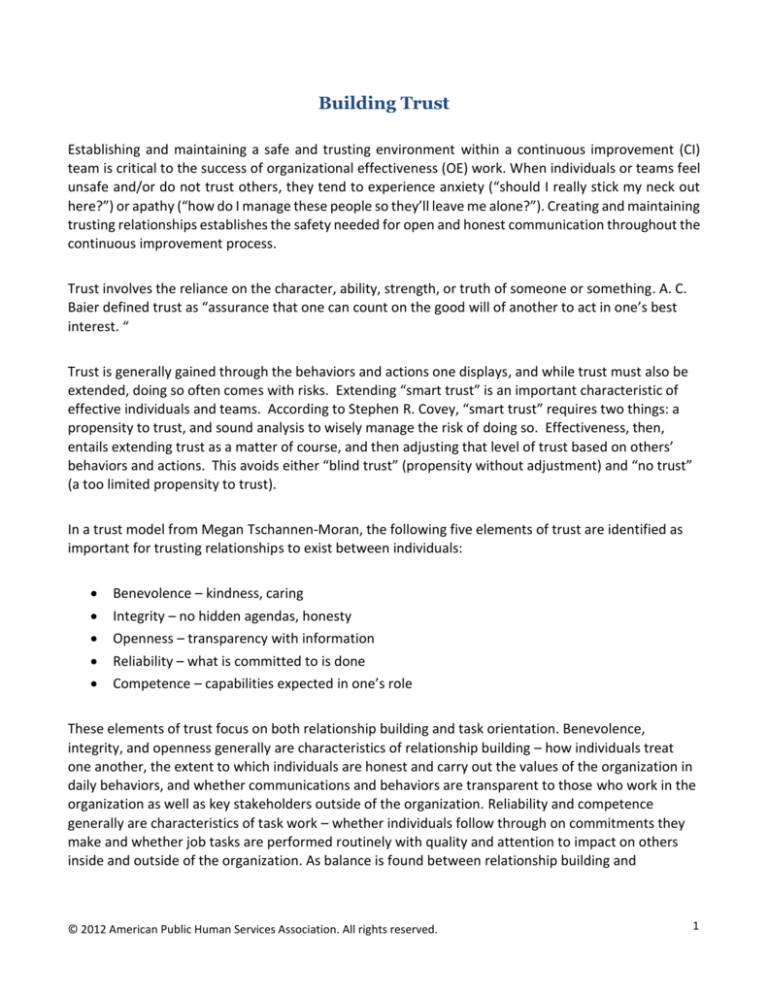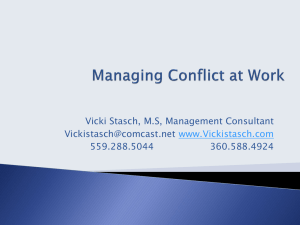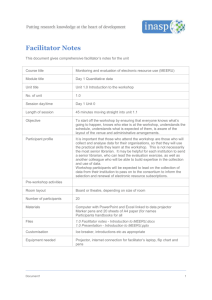
Building Trust
Establishing and maintaining a safe and trusting environment within a continuous improvement (CI)
team is critical to the success of organizational effectiveness (OE) work. When individuals or teams feel
unsafe and/or do not trust others, they tend to experience anxiety (“should I really stick my neck out
here?”) or apathy (“how do I manage these people so they’ll leave me alone?”). Creating and maintaining
trusting relationships establishes the safety needed for open and honest communication throughout the
continuous improvement process.
Trust involves the reliance on the character, ability, strength, or truth of someone or something. A. C.
Baier defined trust as “assurance that one can count on the good will of another to act in one’s best
interest. “
Trust is generally gained through the behaviors and actions one displays, and while trust must also be
extended, doing so often comes with risks. Extending “smart trust” is an important characteristic of
effective individuals and teams. According to Stephen R. Covey, “smart trust” requires two things: a
propensity to trust, and sound analysis to wisely manage the risk of doing so. Effectiveness, then,
entails extending trust as a matter of course, and then adjusting that level of trust based on others’
behaviors and actions. This avoids either “blind trust” (propensity without adjustment) and “no trust”
(a too limited propensity to trust).
In a trust model from Megan Tschannen-Moran, the following five elements of trust are identified as
important for trusting relationships to exist between individuals:
Benevolence – kindness, caring
Integrity – no hidden agendas, honesty
Openness – transparency with information
Reliability – what is committed to is done
Competence – capabilities expected in one’s role
These elements of trust focus on both relationship building and task orientation. Benevolence,
integrity, and openness generally are characteristics of relationship building – how individuals treat
one another, the extent to which individuals are honest and carry out the values of the organization in
daily behaviors, and whether communications and behaviors are transparent to those who work in the
organization as well as key stakeholders outside of the organization. Reliability and competence
generally are characteristics of task work – whether individuals follow through on commitments they
make and whether job tasks are performed routinely with quality and attention to impact on others
inside and outside of the organization. As balance is found between relationship building and
© 2012 American Public Human Services Association. All rights reserved.
1
performing tasks, overall effectiveness of a team or an organization is likely to improve. This balance
and feeling of effectiveness increases trust levels in the team and organization in and of itself.
In low trust teams or organizations, comments such as “we do not trust why management wants that
information for us”, “all management cares about is getting the work done, when was the last time
someone said thank you to us”, “we cannot trust that our workers will do the work correctly”, and “I
do not trust her motives” are heard frequently. In high trust/smart trust work environments comments
such as “I would follow her vision endlessly”, “we have frontline workers that really get the job done
with quality”, and “we understand and support the decisions of management” are the norm.
When safety and trust are identified as gaps by a team during the DAPIM TM process, a facilitator’s role
is to first establish safety and build trust with participants, supporting a learning environment in which
team members feel they can share openly and honestly.
Trust and safety-building can be initiated by a facilitator prior to the DAPIMTM process using a variety of
methods, such as the following:
One-on-one interviews, focus groups, and surveys;
Sharing the kickoff session agenda with participants prior to the session; and,
Sharing information about the facilitator prior to the session.
Trust and safety can continue to be developed during the DAPIMTM process using such methods as the
following:
Sharing information early on in the process about the facilitator’s background and familiarity with
DAPIMTM tools and techniques – if the facilitator is new to the DAPIMTM process this should be
shared openly as a way to be transparent with the participants;
Establishing ground rules for how participants and the facilitator will interact during the sessions
and holding participants accountable to these ground rules, particularly ones concerning
respectful treatment;
Pointing out to the group when it appears there is an “elephant is in the room,” encouraging
them to be open and honest with one another and with the facilitator;
Being open to the ideas of the group and making related changes;
Using the language of participants when recording their discussions, checking-in to ensure
thoughts have been captured as the participants intended, and always working from their points
of view;
Following through with commitments made to the participants during the session in the
timeframes agreed upon; and,
Thanking the participants for their time at the start and end of each session.
© 2012 American Public Human Services Association. All rights reserved.
2
Once teams feel safe with the facilitator and each other in continuous improvement sessions, the
emphasis of facilitation should evolve to building a shared sense of accountability for meeting
demanding goals and following through on commitments made. Teams that feel safe but not
accountable tend to go into a comfort zone where relationships are strong but challenges and hard work
are avoided. The DAPIMTM process itself includes follow through and monitoring as key elements. Both
activities reinforce the task-based elements of trust-building -- reliability and competence. These
activities help facilitators build a shared sense of accountability atop a foundation of team safety. Once
teams demonstrate an ability to follow through on commitments or respond positively to being held
accountable for a lack of follow through, they improve their performance and capacity steadily.
Harvard’s Amy Edmondson has done some excellent work on learning organizations and safety and
accountability. Refer to Chapter 3 of the OE Handbook to read more on Amy Edmondson’s work on
safety and accountability. Consider the Safety and Accountability Matrix from the chapter as you plan
your CI sessions.
A facilitator can use lessons learned from building safety and trust with participants during the
facilitation process to build safety and trust among CI team members. When trust and safety gaps
appear at the individual, team and/or organization-wide level, the following remedies may help,
depending on the root causes identified for the gaps:
Individual Improvement Techniques:
Individual Assessment and Feedback
Personal Development Plans
Coaching and Mentoring
Leadership and Supervisory Platforms
Positive Contacts Initiative
Time Management Activities
Team-Based Improvement Techniques
Team-Building Initiatives
New Leader Assimilation
Decision-Making Charts and Methods
Chartering and Action Planning
Roles, Agendas, and Meeting Protocols
Supervisory Development Programs
© 2012 American Public Human Services Association. All rights reserved.
3
Organization-Wide Improvement Techniques
Internal and External Communication Plans
Strategic Partnerships/Community Development Initiatives
Values Initiative
HR Systems Alignment
Strategic Planning
Improvement Planning
The important thing is for teams to recognize how trust and safety impacts their ability to work
together and ultimately impacts OE work in the organization. It is also important to understand that it
can take years to build trust and safety and yet both can be lost in seconds based on actions and
behaviors.
The facilitator can use the Building Trust in CI Teams Team Activity and power point slides on the
following pages to facilitate a team through a mini-DAPIMTM on building trust and safety, resulting in
quick wins and longer-term improvements to change the way the team works together. A CI team that
has trusting relationships will ultimately be more effective in developing, implementing and monitoring
CI plans in an organization.
© 2012 American Public Human Services Association. All rights reserved.
4
Team Activity: Building Trust
1. Share Amy Edmondson’s work on learning organizations and the Safety and Accountability
Performance Matrix. Also share Covey’s principle of “smart trust.” Be transparent about
activities the facilitator is engaged in to build a safe learning environment for the team.
2. Introduce the work of Tschannen-Moran, trusting work environments include the following
elements:
Benevolent – kindness, caring
Integrity – no hidden agenda’s; honesty
Openness – transparent with information
Reliability – what is committed to is done
Competence – capabilities expected of one’s role
Again, be transparent about the activities the facilitator engaged in to build a trusting learning
environment with the team.
3. Check with participants whether the models hold true for them. You might ask them to share
what parts of the models particularly help them understand safety and trust in work teams.
Check to see if they agree with things you have done as a facilitator to promote trust and
safety. Can they share other examples of trust- and safety-building behaviors by the facilitator
or team members?
4. Point out that Trust and Safety occurs on three levels; individual, team-based, and organizationwide. Ask participants to write down a time they felt trust and safety levels were high in each of
the three levels and a time they felt trust and safety levels were low in each of the three levels.
5. Identify the elements that were missing when trust and safety levels were low. What might be
root causes for the things that got in the way of a trusting and safe work environment? Then
identify possible remedies for the gaps. How can the team build on its current strengths to
overcome the gaps? Consider the following:
Individual Improvement Techniques:
Individual Assessment and Feedback
Personal Development Plans
Coaching and Mentoring
Leadership and Supervisory Platforms
© 2012 American Public Human Services Association. All rights reserved.
5
Time Management Activities
Sharing information with each other; such as personal goals and aspirations and educational
and work background
Following through with individual commitments to the team
Team-Based Improvement Techniques
Team-Building Initiatives
New Leader Assimilation
Decision-Making Charts and Methods
Chartering and Action Planning
Roles, Agendas, and Meeting Protocols
Supervisory Development Programs
Ground roles for team behaviors
Crucial conversations
Organization-Wide Improvement Techniques
Internal and External Communication Plans
Strategic Partnerships/Community Development Initiatives
Values Initiative
HR Systems Alignment
Strategic Planning
Improvement Planning
6. Plan and implement rapid improvements that can be implemented right away to produce quick
wins. Clearly identify how the improvements will be monitored. (Use the Tracking Quick Wins
tool in Section Two of the OE Handbook to chart the rapid improvements agreed to by the team,
as using this tool helps teams monitor agreed upon commitments.)
7. Plan for mid- to long term improvements for which implementation of written continuous
improvement plans and/or engaging others in the organization by charting teams may be
required. Be sure the team considers how to communicate the improvements being made to
support the development of a trusting environment within the CI team and ultimately in the
workplace. As part of the improvement planning process, be sure the team has identified how
to implement and monitor the improvements and make adjustments to ensure the building of a
trusting environment.
© 2012 American Public Human Services Association. All rights reserved.
6
Building Trust in the CI Team Power Point Slides
Safety and Accountability Performance Matrix
© 2011 American Public Human Services Association. All rights reserved.
What is Trust?
Trust is the assurance that one can count on
the good will of another to act in one’s best
interest.
- A.C. Baier
* Trust is essential to initiating and sustaining change.
© 2011 American Public Human Services Association. All rights reserved.
© 2012 American Public Human Services Association. All rights reserved.
7
Defining Trust: Tschannen-Moran Model
Five Elements of Trust
• Benevolence
o
Kindness, caring.
• Integrity
o
No hidden agendas; honesty.
• Openness
o Transparent with information and authority.
• Reliability
o “What is committed to is done.”
• Competence
o
Capabilities expected for one’s role.
© 2004 Tschannen-Moran, Megan.
Trust Matters: Leadership for Successful Schools
© 2011 American Public Human Services Association. All rights reserved.
© 2012 American Public Human Services Association. All rights reserved.
8
Defining Trust: The Relationship-Task Balance
Relationship
Effectiveness
Task
© 2011 American Public Human Services Association. All rights reserved.
© 2012 American Public Human Services Association. All rights reserved.
9









